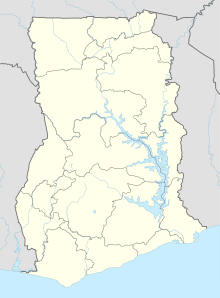| Location | |
|---|---|
| Location | Dunkwa-on-Offin |
| Central Region | |
| Country | Ghana |
| Coordinates | 6°00′32.4″N 1°43′38.8″W / 6.009000°N 1.727444°W |
| Production | |
| Products | Gold |
| Production | 58,696 troy ounces |
| Financial year | Lifetime |
| History | |
| Opened | 2005 |
| Closed | 2005 |
| Owner | |
| Company | Asante Gold Corporation |
| Year of acquisition | 2014 |
The Kubi gold mine is an abandoned mine located 8 kilometres (5.0 mi) northeast of Dunkwa-on-Offin and 22 kilometres (14 mi) south of Obuasi, in Central Region, southern Ghana.[1] It is 180 kilometres (110 mi) northwest of the national capital, Accra.[2]
Ecology
The mine is located in the Supurma Shelterbelft Forest Reserve, identified as a "protection" area, the most vulnerable of the three classification under the Forest Ordinance (CAP 157) of Ghana.[3][4] The Forestry Commission of Ghana has raised the issue that mining in the reserve would jeopardize nearby wildlife, concerns not share by the government-run Officers of the Chamber of Mines, who maintained that they have exclusive right to grand approval for mining.[3]
Geology
The regional geology is of thick steeply dipping sequences of metasediments, alternating with Proterozoic metavolcanic rocks, all part of the Birimian Supergroup, in northeast trending belts. The Kubi mine lies on the western margin of the Ashanti Gold Belt, at the Birimian-Tarwaian contact.[5]
The Kubi project gold mineralisation is contained in a north-northeast trending shear zone in metasediments. Gold occurs associated with 5–15% pyrite and pyrrhotite, and also as coarse gold in narrow quartz veins, in a garnetiferous alteration zone 1–15 metres thick adjacent to the Birimian-Tarwaian contact. Gold mineralisation also occurs in quartz veins that cross-cut the contact. The mineralised zone has a strike length of at least 2,000 metres (6,600 ft) and is open to below 700 metres (2,300 ft) depth.[2]
Project history
Kubi was explored by BHP from 1988 to 1994, who concentrated drilling in an area of pre-existing artisanal mining. Exploration was continued by Nevsun Resources of Canada, until in 1998 Ashanti Goldfields optioned the property and in 2005.[6] AngloGold Ashanti established two small open pits to mine 500,230 tonnes of shallow oxide ore at a grade of 3.65 g/t gold to recover 58,696 troy ounces. The ore was trucked to AngloGold's plant at Obuasi for processing.[2] Prior to mining AngloGold Ashanti's mineral reserve estimate was 550,455 tonnes at a grade of 3.37 g/t gold, totaling 59,637 troy ounces.[5]
The project has a post-mining estimated measured and indicated mineral resource, dated December 2010, of 1.32 million tonnes of ore at a grade of 5.48 g/t containing 133,000 ounces of gold, below the old open pits. 2% of this resource was classified as "oxide". The remainder was classified as "fresh rock".[5]
In 2000, open pit mining was suspended because half of the Kubi deposits were located within a Ghanaian protected forest preserve. In 2002, an Environmental Impact Study was authorized.[7][8] Mining proceed and in 2005 infilling and partial rehabilitation of the open pits was completed.[5]
In 2021 Mining Journal reported that Asante was planning to redevelop the mine,[9] which still has over 300,000 ounces of gold underground.[10]
References
- ^ Nzulu, Gabriel K.; Bakhit, Babak; Högberg, Hans; Hultman, Lars; Magnuson, Martin (September 2021). "Elucidating Pathfinding Elements from the Kubi Gold Mine in Ghana". Minerals. 11 (9): 912. doi:10.3390/min11090912. ISSN 2075-163X.
{{cite journal}}: CS1 maint: unflagged free DOI (link) - ^ a b c Farrow, David (August 2007). "Qualified Person's Report on the Kubi Project Mineral Assets" (PDF). Midrand, South Africa: Golder Associates Africa (Pty) Ltd. Retrieved 24 January 2022.
- ^ a b Hilson, Gavin; Nyame, Frank (2006). "Gold Mining in Ghana's Forest Reserves: A Report on the Current Debate". Area. 38 (2): 175–185. ISSN 0004-0894.
- ^ "Mining Social and Environmental Impacts" (PDF). World Rainforest Movement. March 2004. p. 50. ISBN 9974-7782-6-3.
- ^ a b c d Meadows Smith, Simon; Amanor, Joe (20 October 2014). "NI 43-101 Technical Report - Kubi Gold Project, Ashanti Region, Ghana, West Africa". Accra, Ghana: SEMS Exploration. Retrieved 24 January 2022.
- ^ "2005 Annual Report" (PDF). Johannesburg: AngloGold Ashanti Limited. 28 February 2006. p. 65. Retrieved 30 January 2022.
- ^ "Ghanian forest reserve decision awaited". Mining Journal. 337 (8659): 1. November 9, 2001.
- ^ "Kubi EIS Authorized". Mining Journal. 338 (8672): 9. February 15, 2002.
- ^ "Asante outlines timeline for Bibiani restart". Mining Journal. 9 November 2021. Retrieved 28 February 2022.
- ^ Ecofin, Agence. "Avec le rachat de Bibiani, Asante Gold prépare son entrée dans le cercle des producteurs d'or au Ghana". Agence Ecofin (in French). Retrieved 28 February 2022.
Further reading
- Kesse, G.O. (1985). Mineral and Rock Resources of Ghana (Hardcover). Rotterdam Boston Accord, MA: Taylor & Francis Group, A.A. Balkema Distributed in USA & Canada by A.A. Balkema Publishers. ISBN 9789061916222. ISBN 9061916224.
